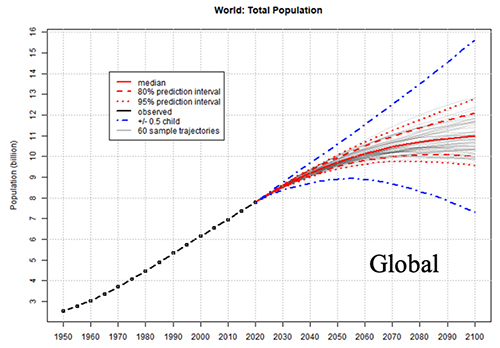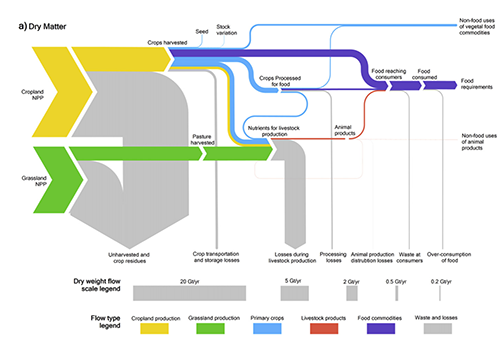
Courtesy UN Population Division. License: CC BY.
This class discusses five readings that explore the primary factors affecting demand for food—population, diet, and food loss. One way to view the demand side of food security is to distinguish increases in population from increases in per capita demand. Cleland (2013) provides a brief review of demography and discusses likely global population growth over the next few decades. This review complements the United Nations population data provided in S1. A major message is that population in many regions will level off, and perhaps even decline during the 21st century. However, large increases can be expected in a few high growth regions such as sub-Saharan Africa. These geographical imbalances will affect food security, trade, and opportunities for economic development. Mismatches between regional demand and production are reflected in S4, which shows that global production of cereal and meat have grown faster than global population while production in East Africa has barely kept up with its rapidly growing population. This situation is especially critical since many residents of East Africa are unable to afford food imports to supplement inadequate local production.
Per capita demand is generally more difficult to predict than population because it depends on many influences, including nutritional requirements, income, and cultural factors. The role of nutrition is discussed by Gomez et al. (2013), who expands the traditional definition of malnutrition to include overnutrition and micronutrient deficiencies as well as undernutrition. Some of the data in S4 show the close connection between income and malnutrition.
Smil (2002) discusses the inefficiencies that arise when plant energy and protein are converted by animals to meat for human consumption. Increases in meat consumption translate into much larger increases in the consumption of vegetal crops for feed and, therefore, into large increases in the demand for natural resources such as land, water, and nutrients. Most dietary predictions suggest that global per capita demand for food will grow over the next several decades. This reflects dietary trends in developing countries, where meat and total calorie consumption tend to increase as incomes rise.

Courtesy Elsevier, Inc., http://www.sciencedirect.com. Used with permission.
Alexander et al. (2017) cover the topic of food loss, which can be viewed either as an increase in demand or a reduction in supply. They estimate global food losses and inefficiencies during production and distribution as well as the impact of food waste at the consumption end of the food chain (further detail from the optional readings is provided in S2). The portion of food lost to pests is considered in the first three sections of Yudelman et al. (1998). Calculations included in S5 show how growing population could combine with dietary change and food loss to significantly increase both global and regional food demand by 2050.
It is reasonable to ask why per capita food demand needs to increase on a global scale, although increases in some regions, such as sub–Saharan Africa, will be essential to ensure proper nutrition. There certainly are ways to reduce per capita demand. Food production losses could probably be decreased through more investment in storage and pest control. Food waste could be reduced through changes in consumer behavior, most likely prompted by price increases. It is also possible that alternative plant-based sources of protein could decrease net crop demand by reducing consumption of less efficient animal-based food products. However, the readings suggest that it is not likely that per capita demand will be substantially decreased through voluntary measures, especially in light of current dietary trends in the developing world, where meat consumption is increasing rather than decreasing.
The significant increase in food demand expected over the next 50 to 100 years motivates us to estimate the additional resources that will be needed to meet this demand. Some simple calculations in S5 illustrate how increasing food demand could affect crop production and associated consumption of critical natural resources. Classes 3 and 4 consider whether our land, water, and nutrient reserves are sufficient to meet this demand.
Required Readings
Population and Demography
- John Cleland. 2013. “World Population Growth; Past, Present and Future.” Environmental and Resource Economics. 55, no. 4: 543–554.
Meat Demand on Crops
- Vaclav Smil. 2002. “Worldwide Transformation of Diets, Burdens of Meat Production and Opportunities for Novel Food Proteins.” Enzyme and Microbial Technology. 30, no. 3: 305–311.
Global Nutrition Survey
- Miguel I. Gomez, Christopher B. Barrett, et al. 2013. “Post-Green Revolution Food Systems and the Triple Burden of Malnutrition.” Food Policy. 42: 129–138.
Food Losses and Inefficiencies during and after Harvest
- Peter Alexander, Calum Brown, et al. 2017. “Losses, Inefficiencies and Waste in the Global Food System.” Agricultural Systems, 153 (2017) 190–200.
Crop Losses to Pests
- Montague Yudelman, Annu Ratta, et al. 1998. Pest Management and Food Production: Looking to the Future (Sections 1–3). International Food Policy Research Institute. Washington, DC 20006–1002.
Optional Readings
Prospects for Global Agriculture
- Nikos Alexandratos and Jelle Bruinsma. 2012. World Agriculture Towards 2030/2050: The 2012 Revision. Food and Agriculture Organization (FAO) of the United Nations. ESA Working Paper no. 12–03.
Nutrition and Food Security
- Mark Gibson. 2012. The Feeding of Nations: Redefining Food Security for the 21st Century. Taylor and Francis. ISBN: 9781439839515.
Food Losses during and after Harvest
- Jenny Gustavsson, Christel Cederberg, et al. 2011. Global Food Losses and Food Waste: Extent, Causes and Prevention. Report commissioned by Food and Agriculture Organization (FAO) of the United Nations.
Pest Losses
- E.-C. Oerke. 2006. “Crop Losses to Pests (PDF).” Journal of Agricultural Science, 144, 31–43.
Discussion Points
- Comparing Ehrlich and Ehrlich (Class 1) to Cleland (Class 2) and to UN projections from S1, do you think population growth is going to be a critical obstacle to meeting human needs in the future? Or is the demographic transition gradually reducing fertility rates to replacement levels?
- Is it realistic to expect significant decreases in food demand through i) population control, ii) dietary change (reduced meat consumption in both developed and undeveloped countries), iii) reduced production losses through investment in infrastructure and better pest control, iv) reduced food waste through consumer education? How would you implement the required changes in policy and behavior?










